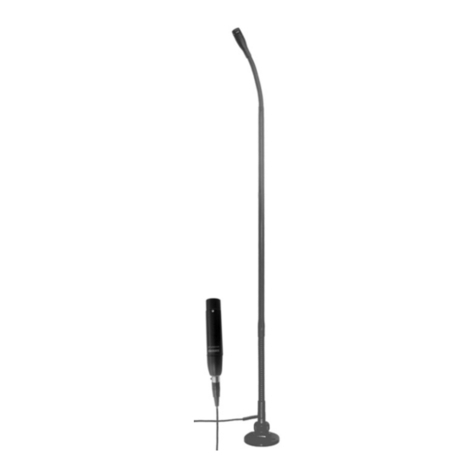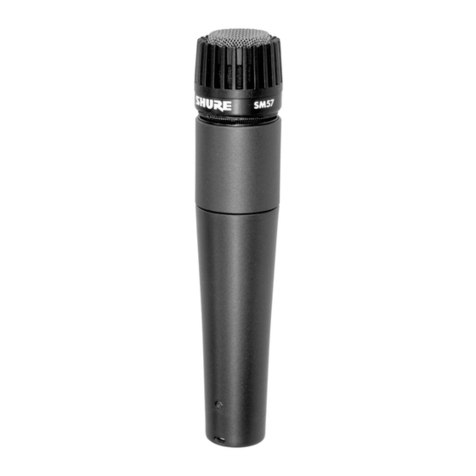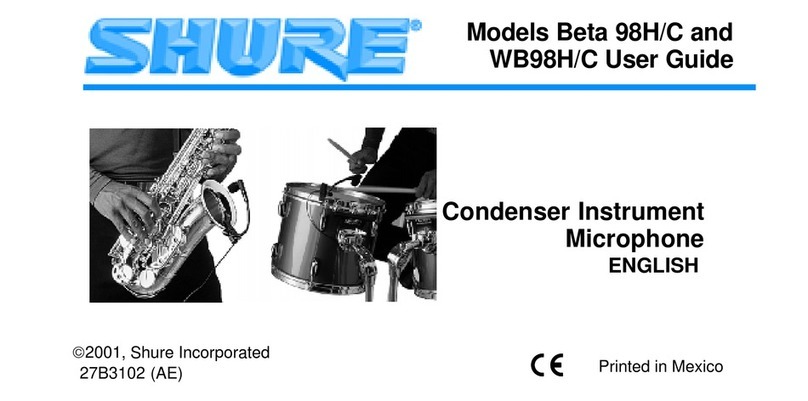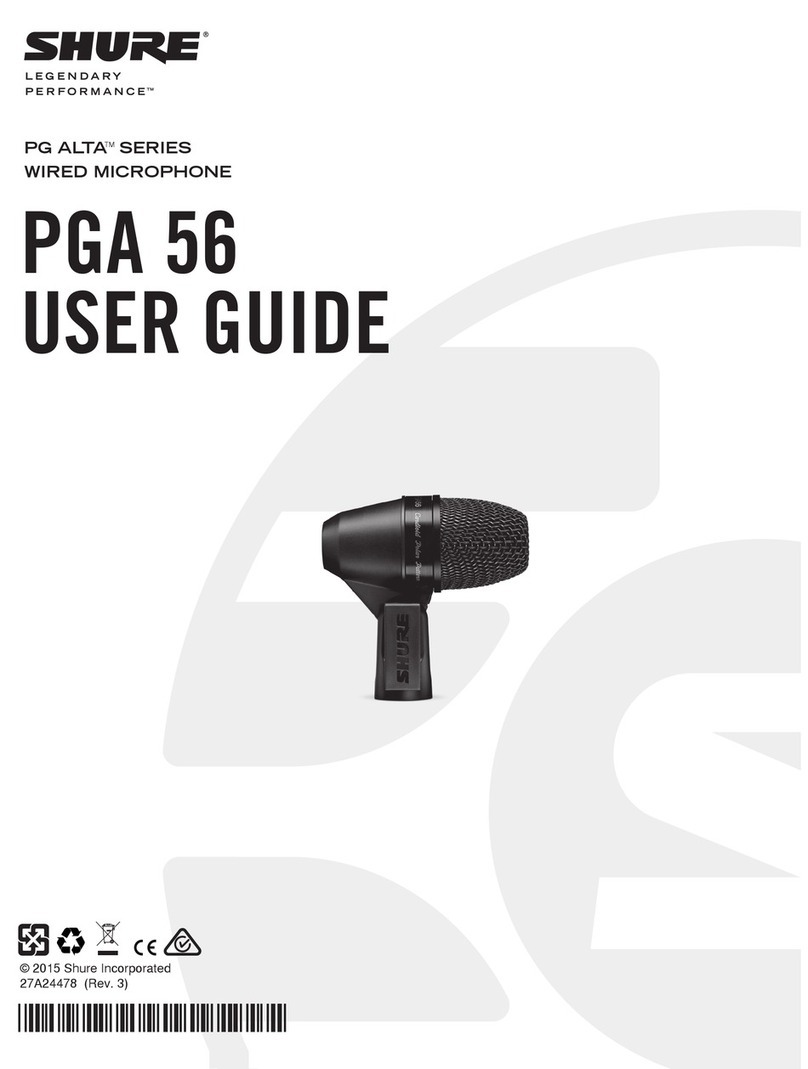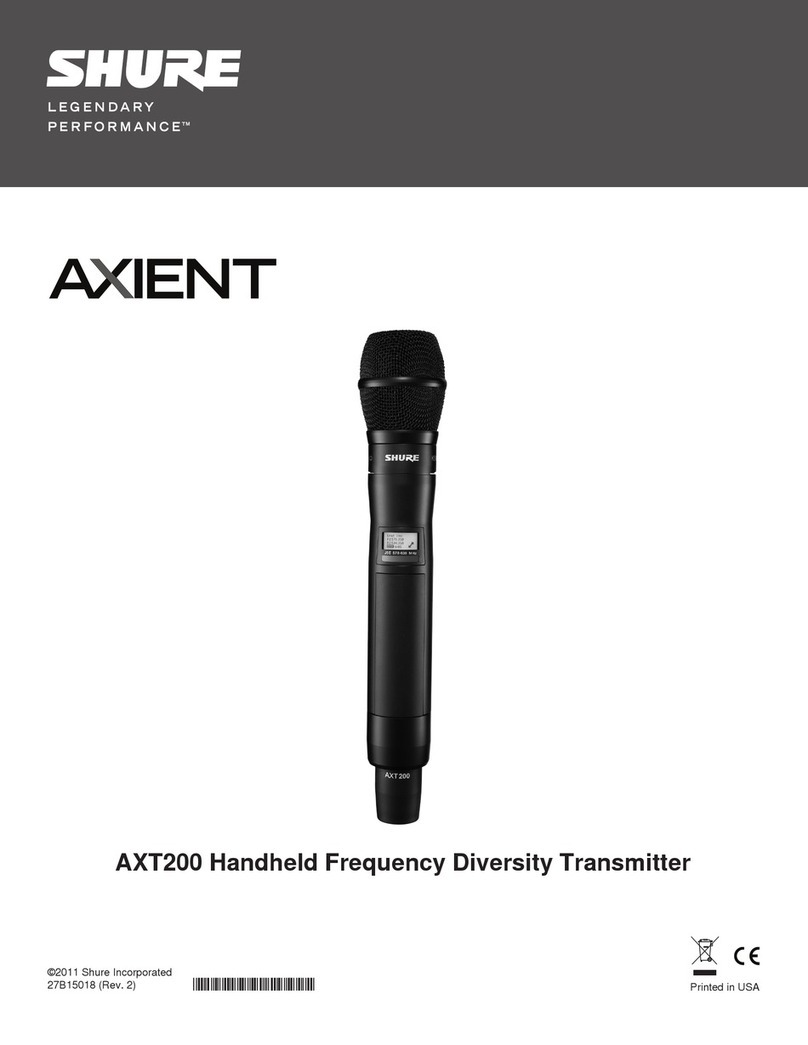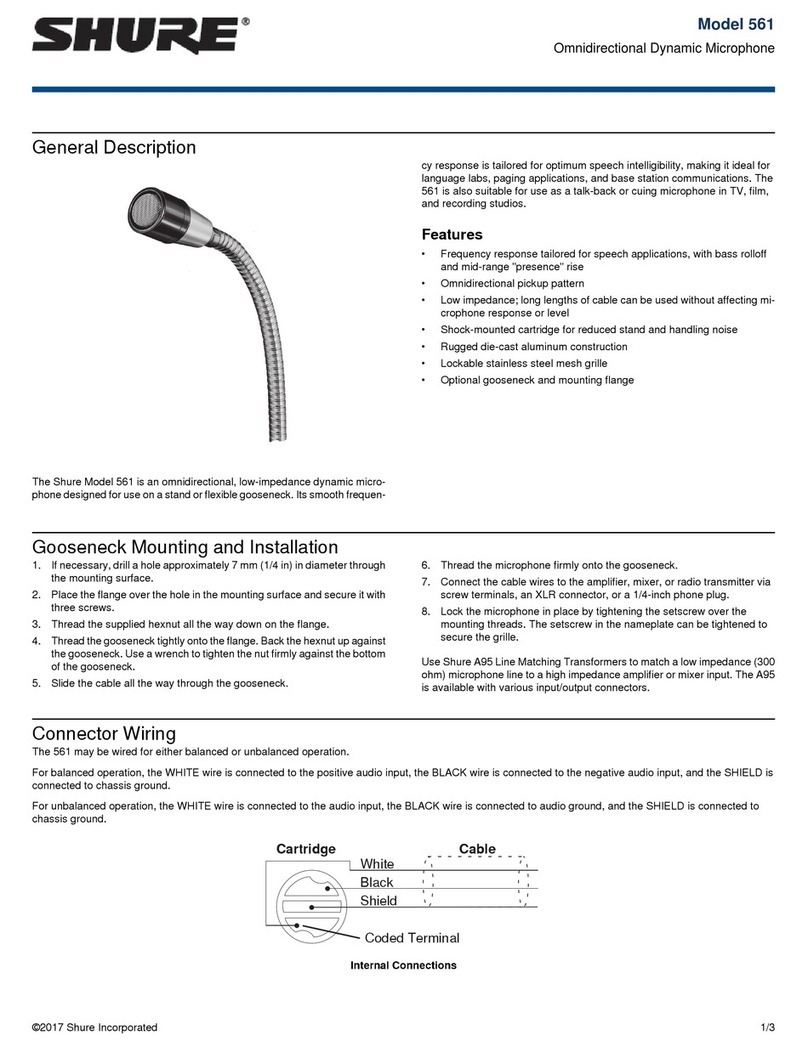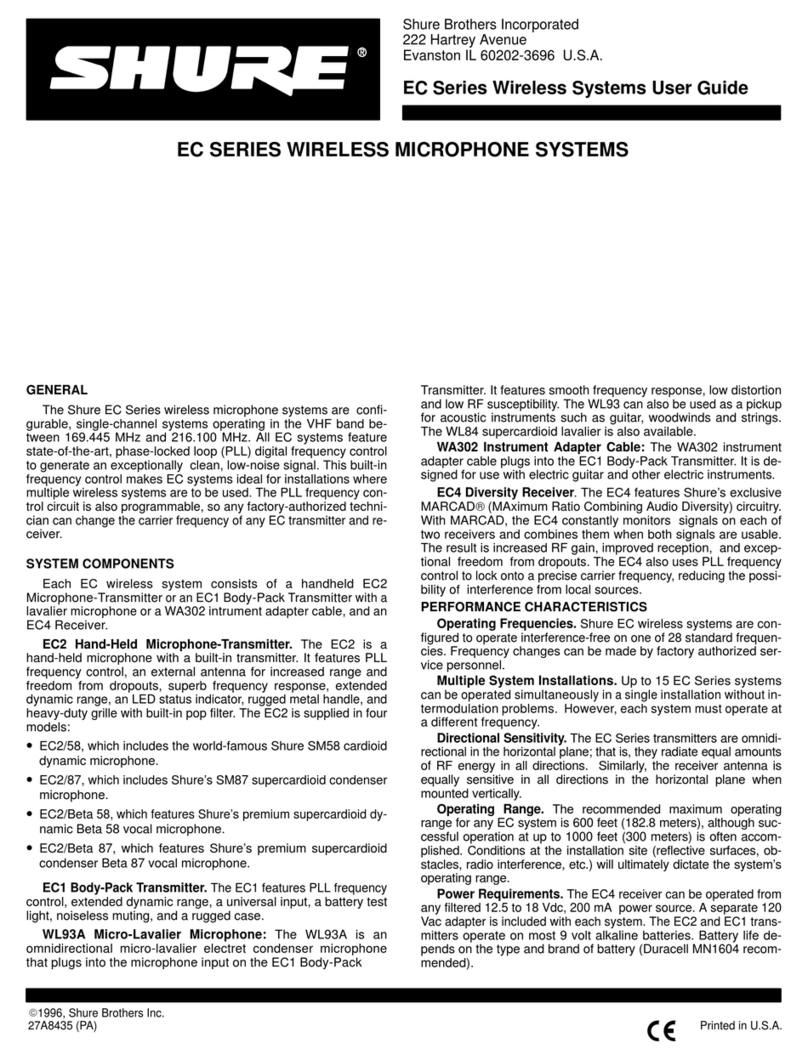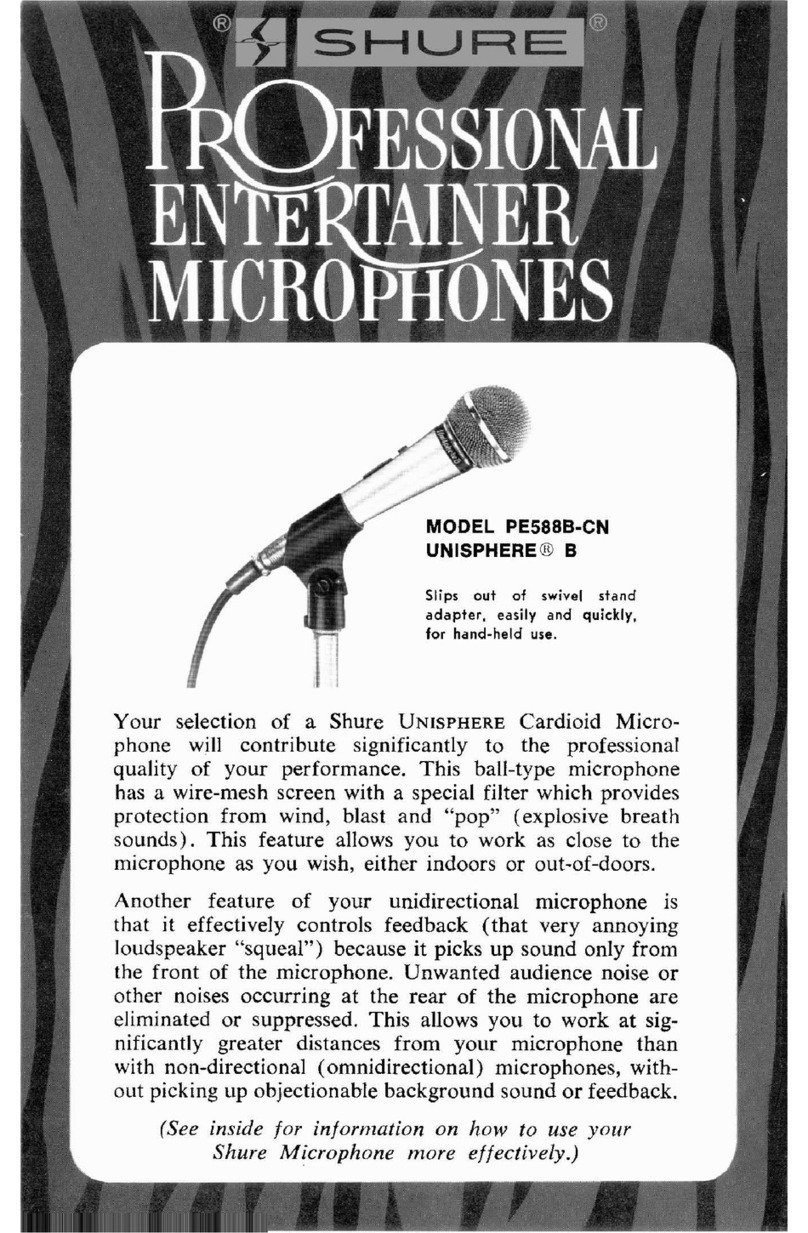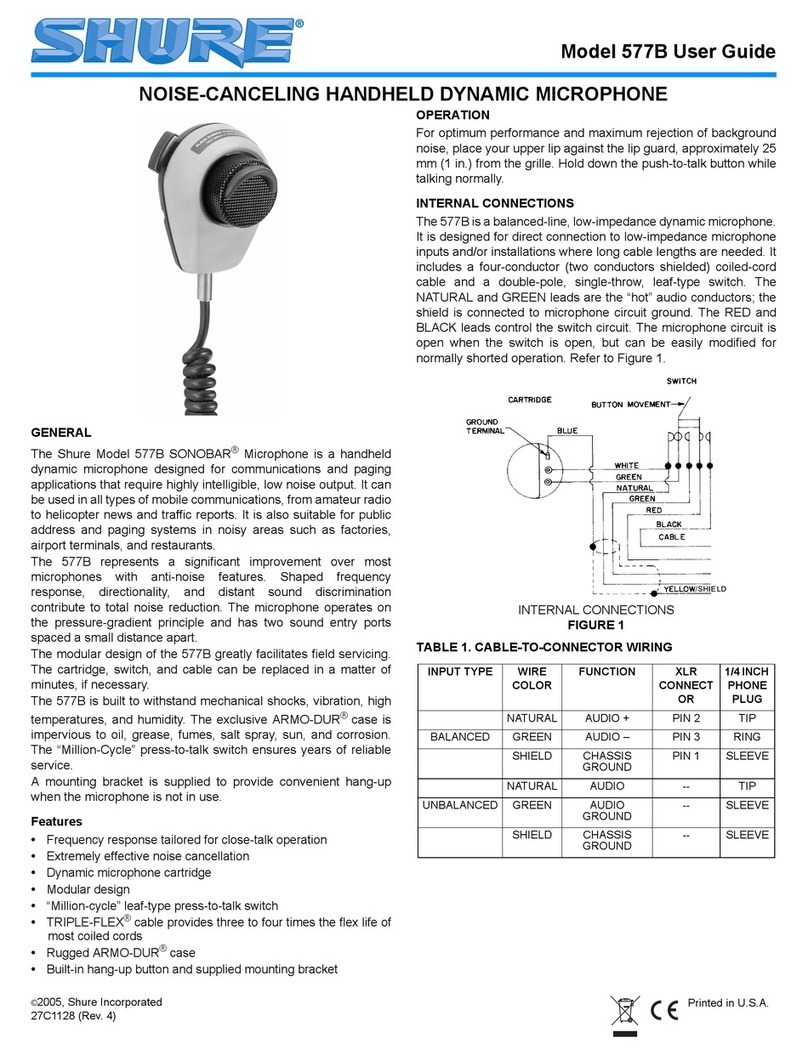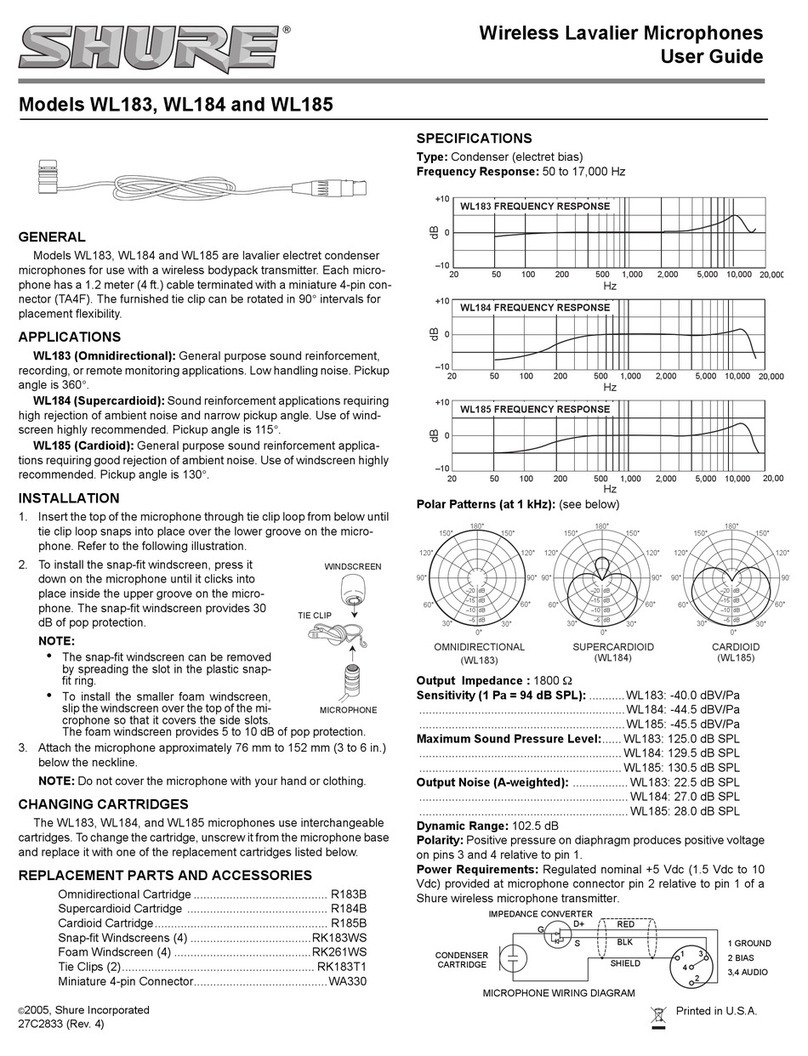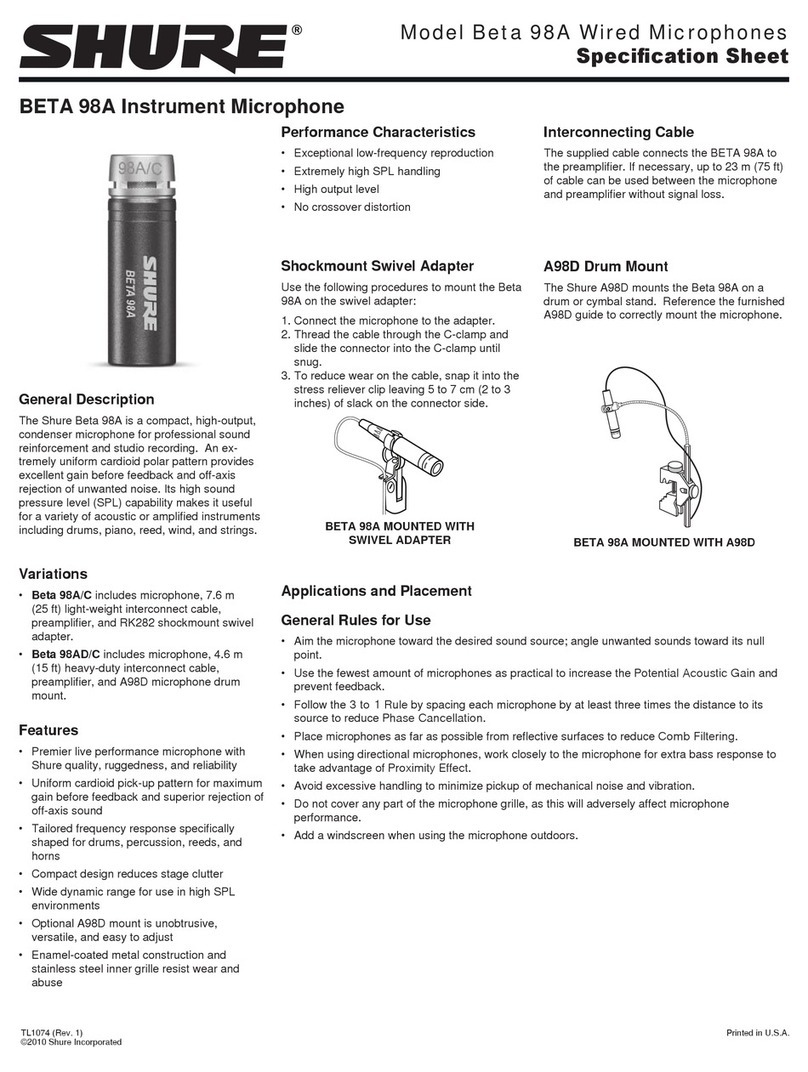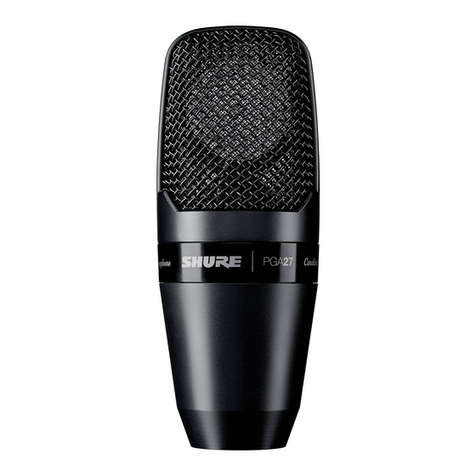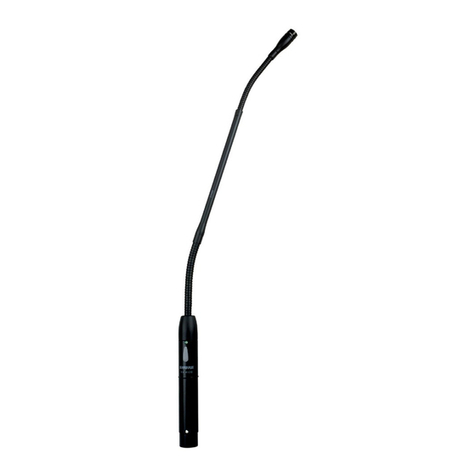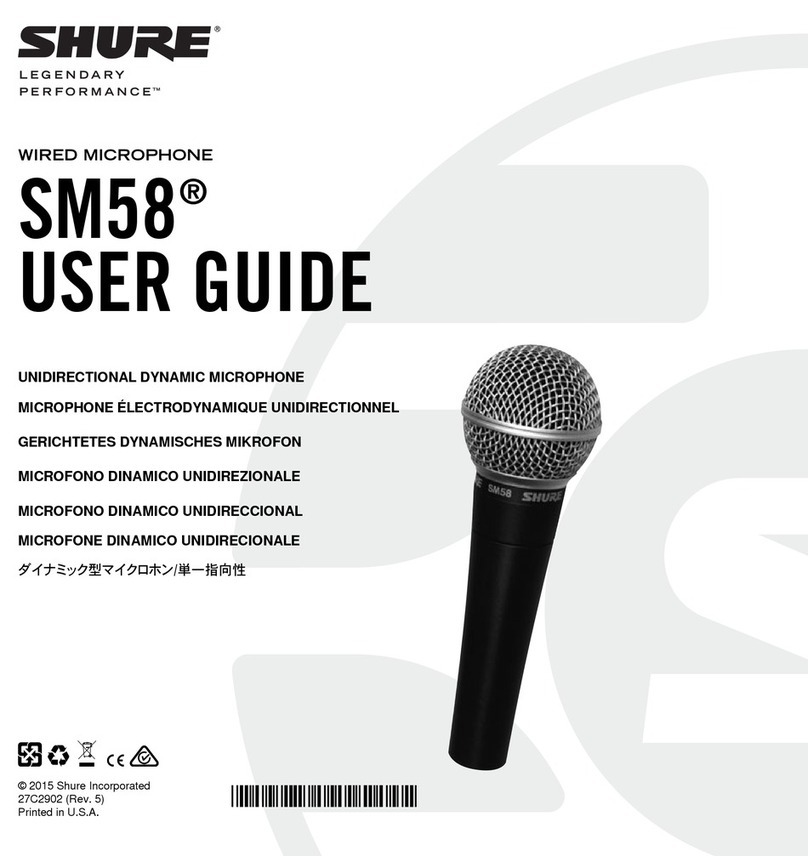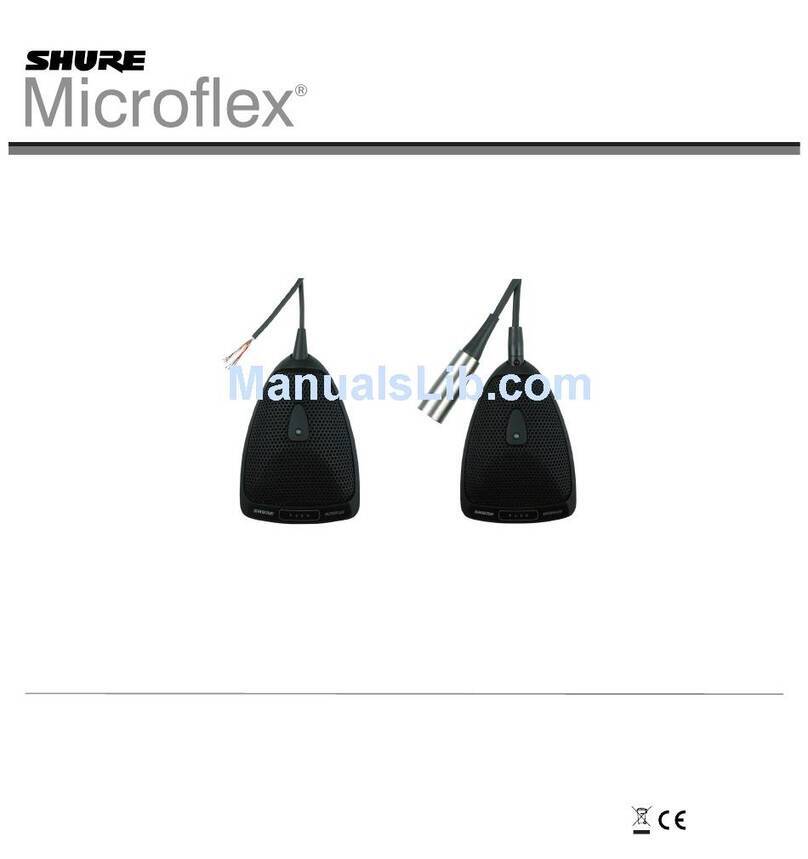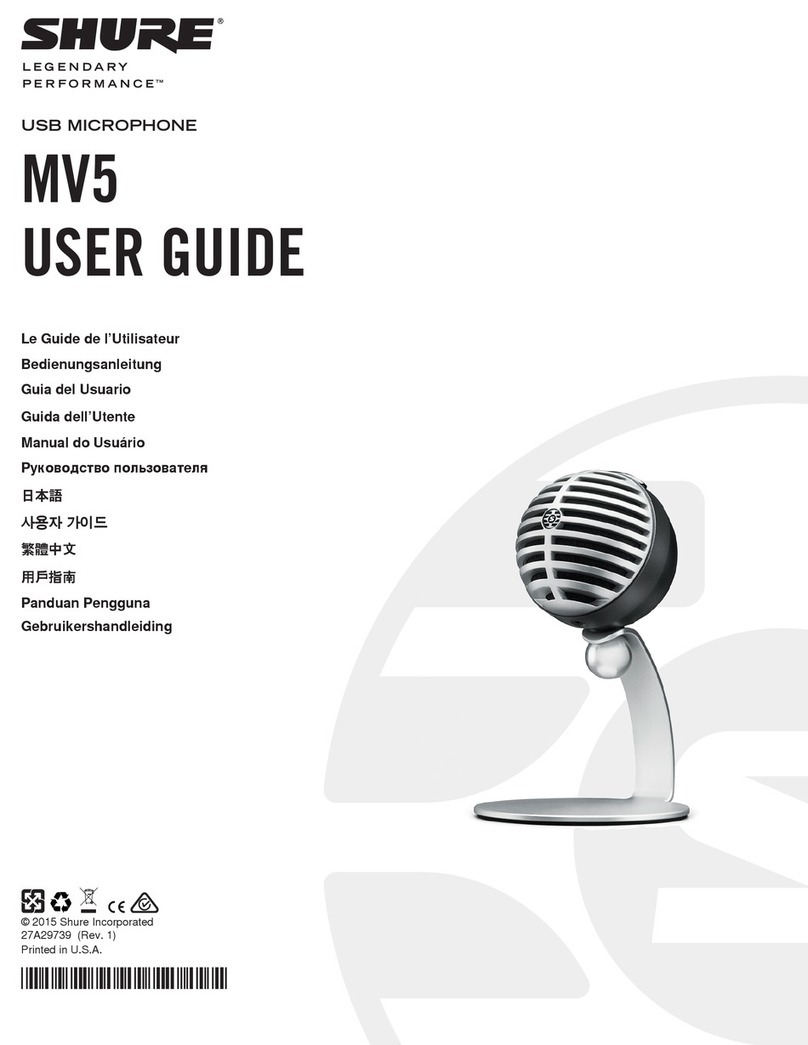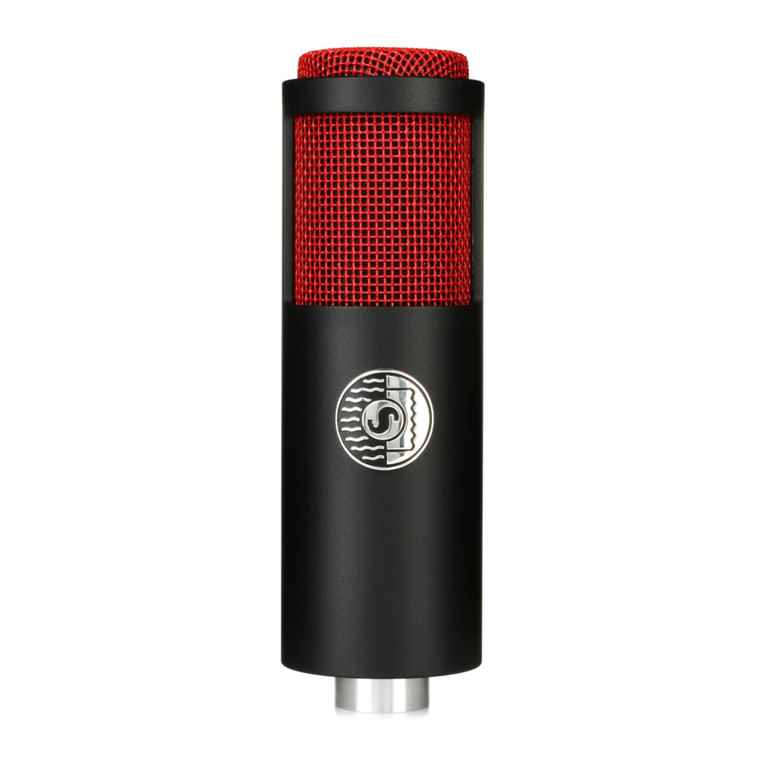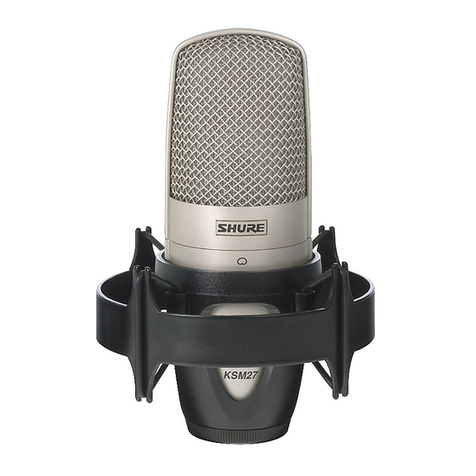
4
GEBRAUCHSANLEITUNG FÜR MICROFLEX®
SCHWANENHALS-MIKROFONE DER REIHE MX400/
MX400S
ALLGEMEINES
Shure MicroflexâMikrofone der Reihe MX400 sind schwanenhals-
montierte Mini-Elektretkondensatormikrofone, die in erster Linie für
Sprach- und Gesangsaufnahmen vorgesehen sind. Sie können auf
Rednerpulten, Kanzeln oder Konferenztischen befestigt werden. Alle
Modelle enthalten einen Vorverstärker und sind mit austauschbaren
Kardioiden-, Superkardioiden- oder Allrichtungskapseln lieferbar.
MERKMALE
• Breiter Dynamikbereich und Frequenzgang für genaue Tonwie-
dergabe über das gesamte Tonfrequenzspektrum hinweg
• Austauschbare Kapseln, die ein optimales Polarmuster für
jeden Verwendungszweck ermöglichen
• Ausgeglichene, transformatorlose Ausgabe für erhöhte Raus-
chunempfindlichkeit bei langen Kabelführungen
• Schwingdämpfer, der über 20 dB Isolierung von Oberflächenvi-
brationsgeräuschen bietet
• Einrastender Befestigungsflansch zur dauerhaften Anbringung
des Mikrofons auf Rednerpulten, Kanzeln oder Konferenztis-
chen
• Steckrast-Windschirm aus Schaumstoff
MODELLVARIANTEN
MX412: Mikrofon mit 305 mm langem Schwanenhals.
MX418: Mikrofon mit 457 mm langem Schwanenhals.
MX412S
: Mikrofon mit 305 mm langem Schwanenhals einschließlich
Stummschalter und LED.
MX418S
: Mikrofon mit 457 mm langem Schwanenhals einschließlich
Stummschalter und LED.
AUSWAHL EINER RICHTCHARAKTERISTIK
Alle Microflexâ-Mikrofone sind mit einer von drei austauschbaren
Kapseln lieferbar. Das Polarmuster der Kapsel wird durch das Mod-
ellnummer-Suffix angegeben.
/C = Kardioid, /S = Superkardioid, /O= Alle Richtungen
Kardioid (C). Für allgemeine Tonverstärkungsanwendungen emp-
fohlen. Ansprechwinkel (-3 dB) = 130°.
Superkardioid (S). Für Tonverstärkungsanwendungen empfohlen,
die eine engere oder weiter entfernte Abdeckung erfordern. Ansprech-
winkel (-3 dB) = 115°.
Alle Richtungen (O). Für Aufzeichnungs- oder Fernüberwachung-
sanwendungen empfohlen. Ansprechwinkel = 360°.
ALLGEMEINE INSTALLATIONSRICHTLINIEN
1. Das Mikrofon auf die gewünschte Schallquelle, wie z.B. auf den
Redner, und weg von unerwünschten Schallquellen, wie z.B.
einem Lautsprecher, richten.
2. Die Spitze des Mikrofons in einer Entfernung von 15 bis 30 cm
von der gewünschten Schallquelle plazieren.
3. Stets den mitgelieferten Windschirm oder wahlweise den Met-
all-Windschirm benutzen, um Atemgeräusche zu unterdrücken.
4. Wenn vier oder mehr Mikrofone gleichzeitig verwendet werden
sollen, ist der Einsatz einer automatischen Mischstufe, wie z.B.
Shure SCM810 oder FP410, zu empfehlen.
INSTALLATION DES MIKROFONS
Anbringung eines Mikrofons in einem Befestigungsflansch
(Abbildung 2 auf Seite 8)
1. An der gewünschten Stelle ein Loch mit 22 mm Durchmesser
bohren.
2. Drei Ansatzlöcher für die mitgelieferten Schrauben markieren und
bohren; dabei den Flansch als Schablone benutzen.
3. Den Vorverstärker durch den Befestigungsflansch einführen.
4. Den Sicherungsring des Befestigungsflansches über die
Unterseite des Vorverstärkers und nach oben schieben, bis er
fluchtgerecht zur Unterseite des Flansches liegt. Danach den
Ring fest andrücken.
5. Den Flansch mit drei Schrauben an der Befestigungsfläche
festschrauben.
Anbringung eines Mikrofons in einem Schwingdämpfer
(Abbildung 1 auf Seite 8)
1. An der gewünschten Stelle ein Loch mit 44 mm Durchmesser
bohren.
2. Drei Ansatzlöcher für die Schrauben markieren und bohren; dabei
den Schwingdämpfer als Schablone benutzen.
3. Den Schwingdämpfer mit drei Schrauben an der Befestigungs-
fläche festschrauben.
Anbringung des Schaumstoff-Windschirms
(Abbildung 3 auf Seite 8)
1. Den Schaumstoff-Windschirm auf das Mikrofon drücken, bis er in
die Rille unterhalb der Kapsel einrastet.
2. Zum Abnehmen des Windschirms den Spalt in seinem Befesti-
gungsring mit einem Schraubenzieher oder Daumennagel ausein-
ander spreizen und den Windschirm vorsichtig abziehen.
EINSTELLUNG DER VORVERSTÄRKER-VERSTÄRKUNG: NUR
MX412 UND MX418 (ABBILDUNG 4 AUF SEITE 9)
MX412 und MX418 Mikrofone enthalten einen Vorverstärker mit
Verstärkungseinstellung, der dem Benutzer ermöglicht, eine 12-dB-
oder 0-dB-Verstärkungseinstellung zu wählen. Der Vorverstärker wird
mit der 12-dB-Einstellung versandt. Die Verstärkung kann um 12 dB
verringert werden, indem die Vorverstärker-Jumper auf die 0-dB-Ein-
stellung verlegt werden.
TECHNISCHE DATEN
Frequenzgang (Abbildung 5 auf Seite 9)
50 bis 17.000 Hz
Polarmuster (Abbildung 5 auf Seite 9)
Ausgangsimpedanz (1000 Hz)
Ist-Wert: 180 W(Nennwert: 150 W)
Leerlaufempfindlichkeit (bei 1 kHz, bezogen auf 1 V/Pascal*)
Kardioid: -35,0 dB (17,8 mV)
Superkardioid: -33,5 dB (21,1 mV)
Alle Richtungen: -27,5 dB (42,2 mV)
Alle Einstellungen -12 dB bei Gewinn 0
*1 Pascal = 94 dB Schalldruckpegel
Maximaler Schalldruckpegel (1 kHz bei 1% Klirrfaktor, 1 kWLast)
Kardioid: 124,2 dB
Superkardioid: 122,7 dB
Alle Richtungen: 116,7 dB
Alle Einstellungen +6 dB bei Gewinn 0
Äquivalentausgangsrauschen (mit A-Gewichtung)
Kardioid: 28,0 dB Schalldruckpegel
Superkardioid: 26,5 dB Schalldruckpegel
Alle Richtungen: 20,5 dB Schalldruckpegel
Rauschabstand (bezogen auf 94 dB Schalldruckpegel)
Kardioid: 66,0 dB
Superkardioid: 67,5 dB
Alle Richtungen: 73,5 dB
Dynamikbereich bei 1 kWBelastung
96,2 dB
100 dB bei Gewinn 0
Gleichtaktunterdrückung
mindestens 45,0 dB
Stummschalterdämpfung (nur bei geschalteten Modellen)
mindestens 50,0 dB
Vorverstärkerausgang-Begrenzungspegel (1 % Klirrfaktor)
-6,0 dBV (0,5 V)
-12 dB bei Gewinn 0
Polarität
Positiver Schalldruck an der Membran erzeugt positive Spannung
an Stift 2 in bezug auf Stift 3 des Ausgangssteckverbinders.
Leistungsbedarf
11 bis 52 V Phantom-Gleichspannung, 2,0 mA
Umgebungsbedingungen
Betriebstemperaturbereich: -18 bis 57 °C
Relative Feuchtigkeit: 0 to 95 %
